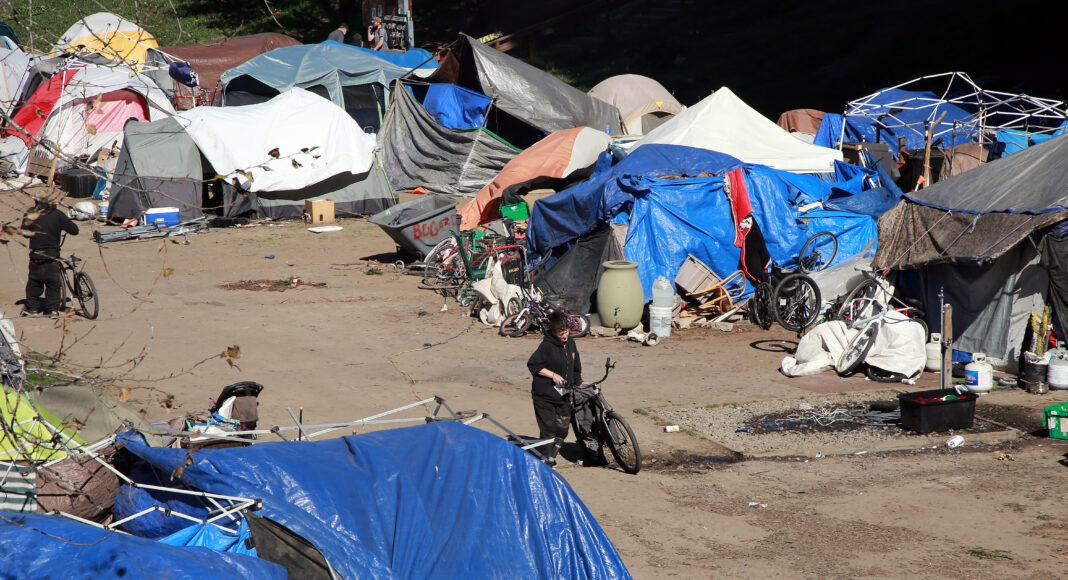The Santa Cruz City Council on Tuesday adopted a three-year Homelessness Response Action Plan, which focuses on establishing permanent housing and expanding existing shelter services while closing temporary and unsanctioned camps within the city such as the Benchlands.
The report was the first of what will be a quarterly homelessness response programming update to the council.
The plan combines mental health and other services and encourages non-law enforcement response when possible, for an around-the-clock alternative emergency crisis response program.
“The action plan represents a shift, really moving to a more integrated and holistic approach to the city’s homelessness response, moving from being reactive and looking at temporary fixes to be more proactive and working toward permanent and sustainable solutions,” said Santa Cruz Homelessness Response Manager Larry Imwalle. “It balances individual needs with managing community impacts—that’s the overarching frame that’s really guiding this.”
In addition, city officials plan to work with other jurisdictions and nonprofits to identify 20 new locations for sheltering.
“To be successful and impact this issue really takes the entire community,” Imwalle said.
A large part of Tuesday’s discussion was how the City will spend $14 million it received recently from the State Legislature to help address its growing problem with homelessness.
The approved plan proposes the following spending:
- $3 million for funding a shelter at 125 Coral St., including acquiring an existing business at that address
- $1.9 million for repairs to a shower facility at the Housing Matters shelter at 117 Coral St.
- $500,000 for pre-development work for a navigation center and other improvements on the Coral Street campus
- $1.09 million for pallet shelters, which are small, portable, easy-to-assemble single-story units
- $1.04 million to fund safe parking services
- $1.3 million for increased sheltering
- $2.4 million to increase services at the Armory
The money will also go toward funding new positions such as mental health specialists and resource and land management that will cost upwards of $1 million. That is a significant shift from the previous homelessness response, which is described as “an amalgamation of decentralized work spanning 12 City departments.”
Also included in the plan is the protection and restoration of natural areas that have been impacted by unsanctioned encampments, to enforce existing environmental protection regulations and pursue new regulations that would further protect habitats.
Already, Santa Cruz-based Housing Matters is working with the City and the County of Santa Cruz to provide an additional 120 shelter beds in the form of Pallet Shelters.
The plan also seeks to establish safe parking programs, including parking restrictions on City streets between midnight and 5am, a new residential permit program and the restriction of discharging sewage or gray water on streets or in storm drains.
It will also create a waste disposal program for people who live in recreational vehicles and provide storage spaces for people experiencing homelessness.
Homelessness nationwide grew exponentially during the Covid-19 pandemic. In Santa Cruz County, the number of emergency shelter and transitional housing beds reached a peak of 1,008 beds, more than doubling the pre-Covid shelter capacity.
And without a solution, the problem stands to get worse, as state and federal funding for Covid-19 responses expires or runs out.
The one-time allocation from the state will cover the bulk of the first-year costs with implementing the Action Plan—estimated at $14.5 million—with the remainder being drawn from Community Development Block Grants, American Rescue Plan Act funds and the City’s General Fund.
Because the one-time funding will pay for one year of the new positions, city officials will have to seek new revenue sources to keep them, Imwalle said.
“This is probably the most challenging issue in our community, and one of our biggest responsibilities,” he said. “So it’s going to require ongoing investment.”
The issue will return to the council in May, when they will further hammer out details of the plan.













